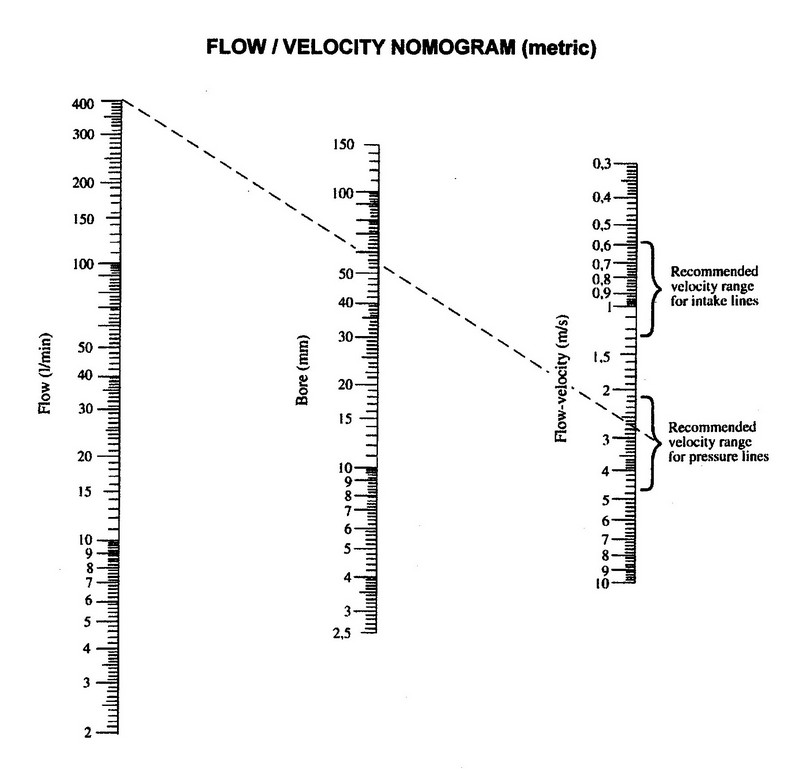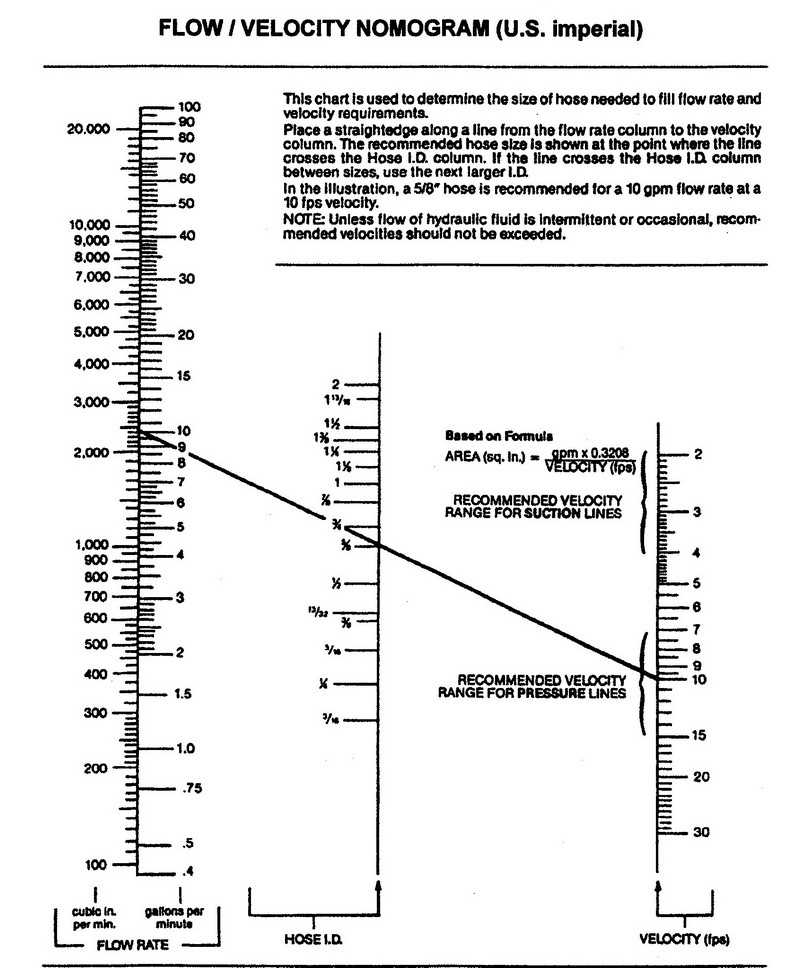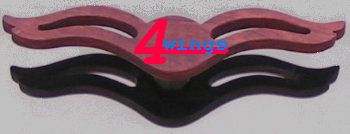|
Velocity
and pressure drop in pipes formulas and calculator
Velocity
The velocity of hydraulic fluid through a conductor (pipe, tube or
hose) is dependent on flow rate and cross sectional area. Recommended
fluid velocities through pipes and hoses in hydraulic systems are as
follows:
| Service |
Velocity
(ft/sec) |
Velocity
(m/sec) |
| suction/intake |
2-4 |
0.6 - 1.2 |
| return |
4 - 13 |
1.5 - 4 |
| pressure /
discharge |
7 - 8 |
2 - 5.5 |
Use values at the lower end of the range for lower pressures or where
operation is continuous. Refer to the flow/velocity nomograms at the
centre of this file for more information, alternatively, fluid
velocity can be calculated using the following formula:
v = Q � 0.408
D�
Where :
v = velocity in feet per second (ft/sec)
Q = flow rate in US gallons per minute (USgpm)
D = inside diameter of pipe or hose in inches (in)
In metric units:
v = Q � 21.22
D�
Where :
v = velocity in metres per second (m/sec)
Q = flow rate in litres per minute (L/min)
D = inside diameter of pipe or hose in millimetres (mm)
Pressure drop
Friction between the fluid flowing through a conductor and its inside
wall causes losses, which are quantified as pressure drop. Pressure
drop in conductors is an important consideration for the designer
especially in systems where long pipe or hose runs are necessary. The
pressure drop over a length of pipe or hose can be calculated using the
following formula, which for ease of calculation uses metric units.
Before proceeding to the pressure drop calculations, the following
variables need to be known:
Flow rate in litres per minute (L/min) Q
Inside diameter of pipe or hose in millimetres (mm) D
Kinematic viscosity of fluid (at operating temperature) in centistokes
(cSt) ν
Density of the fluid in kilograms per cubic metre (kg/m�) ρ
Length of the pipe, tube or hose in metres (m) L
1. Calculate fluid velocity:
v = Q � 21.22
D�
Where:
v = velocity in metres per second (m/sec)
Q = flow rate in litres per minute (L/min)
D = inside diameter of pipe or hose in millimetres (mm)
2. Calculate the Reynolds Number
(Re):
Re = 1000 � v � D
ν
Where:
Re = Reynolds Number
v = velocity in metres per second (m/sec)
D = inside diameter of pipe or hose in millimetres (mm)
ν = kinematic viscosity of fluid (at operating temperature) in
centistokes (cSt)
3. Calculate the friction factor
(f)
The formula used to calculate the friction factor is
dependent on the magnitude of the Reynolds Number.
If the Reynolds Number is less than 2300, flow is laminar and the
following formula is used to calculate the friction factor:
f = 64
Re
Where :
f = friction factor
Re = Reynolds Number < 2300
If the Reynolds Number is between 2300 and 4000, flow is
transition and greater than 4000 flow is turbulent.
For Reynolds Numbers greater than 2300 and less than 100,000 the
following formula can be used to calculate the friction factor:
f = 0.3164 � Re - 0.25
Where :
f = friction factor
Re = Reynolds Number > 2300 and < 100,000
In instances where the Reynolds Number is greater than 100,000,
friction is highly dependant on the roughness of the conductor’s inner
surface. In these cases Colebrook’s equation, which considers pipe
roughness, is used to calculate the friction factor.
However, due to the relatively low fluid velocities and high fluid
viscosities present in hydraulic systems, Reynolds Numbers of this
magnitude should not be encountered.
4. Calculate the pressure drop:
Finally, pressure drop can be calculated using the following formula:
Δp = v� � f � L � ρ
2D
Where :
Δp = pressure drop in Pascals (Pa)
v = velocity in metres per second (m/sec)
f = friction factor
L = length of pipe or hose in metres (m)
ρ = density of the fluid in kilograms per cubic metre (870-890 kg/m�
for hydraulic oil)
D = inside diameter of pipe or hose in metres (m)
Conversions:
US gallon * 3.785 = Liter
inch
* 25.4 = Milimetre
inch
* 0.0254 = Metre
feet
* 0.3048 = Metre
lb/ft3
* 16.02 = kg/m3
Pascal (Pa) / 100000= bar
Pascal (Pa) * 0.000145 = psi


� 2013
www.4wings.com
Kinematic
viscosity for some common fluids are indicated below:
| Liquid |
Temperature |
Kinematic
Viscosity |
| (oF) |
(oC) |
CentiStokes (cSt) |
Seconds Saybolt Universal (SSU) |
| Acetaldehyde CH3CHO |
61
68 |
16.1
20 |
0.305
0.295 |
36 |
| Acetic acid - vinegar - 10% CH3COOH |
59 |
15 |
1.35 |
31.7 |
| Acetic acid - 50% |
59 |
15 |
2.27 |
33 |
| Acetic acid - 80% |
59 |
15 |
2.85 |
35 |
| Acetic acid - concentrated glacial |
59 |
15 |
1.34 |
31.7 |
| Acetic acid anhydride (CH3COO)2O |
59 |
15 |
0.88 |
|
| Acetone CH3COCH3 |
68 |
20 |
0.41 |
|
| Alcohol - allyl |
68
104 |
20
40 |
1.60
0.90 cp |
31.8 |
| Alcohol - butyl-n |
68 |
20 |
3.64 |
38 |
| Alcohol - ethyl (grain) C2H5OH |
68
100 |
20
37.8 |
1.52
1.2 |
31.7
31.5 |
| Alcohol - methyl (wood) CH3OH |
59
32 |
15
0 |
0.74
1.04 |
|
| Alcohol - propyl |
68
122 |
20
50 |
2.8
1.4 |
35
31.7 |
| Aluminum sulfate - 36% solution |
68 |
20 |
1.41 |
31.7 |
| Ammonia |
0 |
-17.8 |
0.30 |
|
| Aniline |
68
50 |
20
10 |
4.37
6.4 |
40
46.4 |
| Asphalt RC-0, MC-0, SC-0 |
77
100 |
25
37.8 |
159-324
60-108 |
737-1.5M
280-500 |
| Automatic crankcase oil SAE 10W |
0 |
-17.8 |
1295-max |
6M-max |
| Automatic crankcase oil SAE 10W |
0 |
-17.8 |
1295-2590 |
6M-12M |
| Automatic crankcase oil SAE 20W |
0 |
-17.8 |
2590-10350 |
12M-48M |
| Automatic crankcase oil SAE 20 |
210 |
98.9 |
5.7-9.6 |
45-58 |
| Automatic crankcase oil SAE 30 |
210 |
98.9 |
9.6-12.9 |
58-70 |
| Automatic crankcase oil SAE 40 |
210 |
98.9 |
12.9-16.8 |
70-85 |
| Automatic crankcase oil SAE 50 |
210 |
98.9 |
16.8-22.7 |
85-110 |
| Automotive gear oil SAE 75W |
210 |
98.9 |
4.2 min |
40 min |
| Automotive gear oil SAE 80W |
210 |
98.9 |
7.0 min |
49 min |
| Automotive gear oil SAE 85W |
210 |
98.9 |
11.0 min |
63 min |
| Automotive gear oil SAE 90W |
210 |
98.9 |
14-25 |
74-120 |
| Automotive gear oil SAE 140 |
210 |
98.9 |
25-43 |
120-200 |
| Automotive gear oil SAE150 |
210 |
98.9 |
43 - min |
200 min |
| Beer |
68 |
20 |
1.8 |
32 |
| Benzene (Benzol) C6H6 |
32
68 |
0
20 |
1.0
0.74 |
31 |
| Bone oil |
130
212 |
54.4
100 |
47.5
11.6 |
220
65 |
| Bromine |
68 |
20 |
0.34 |
|
| Butane-n |
-50
30 |
-1.1 |
0.52
0.35 |
|
| Butyric acid n |
68
32 |
20
0 |
1.61
2.3 cp |
31.6 |
| Calcium chloride 5% |
65 |
18.3 |
1.156 |
|
| Calcium chloride 25% |
60 |
15.6 |
4.0 |
39 |
| Carbolic acid (phenol) |
65
194 |
18.3
90 |
11.83
1.26 cp |
65 |
| Carbon tetrachloride CCl4 |
68
100 |
20
37.8 |
0.612
0.53 |
|
| Carbon disulfide CS2 |
32
68 |
0
20 |
0.33
0.298 |
|
| Castor oil |
100
130 |
37.8
54.4 |
259-325
98-130 |
1200-1500
450-600 |
| China wood oil |
69
100 |
20.6
37.8 |
308.5
125.5 |
1425
580 |
| Chloroform |
68
140 |
20
60 |
0.38
0.35 |
|
| Coconut oil |
100
130 |
37.8
54.4 |
29.8-31.6
14.7-15.7 |
140-148
76-80 |
| Cod oil (fish oil) |
100
130 |
37.8
54.4 |
32.1
19.4 |
150
95 |
| Corn oil |
130
212 |
54.4
100 |
28.7
8.6 |
135
54 |
| Corn starch solution, 22 |
70
100 |
21.1
37.8 |
32.1
27.5 |
150
130 |
| Corn starch solution, 24 |
70
100 |
21.1
37.8 |
129.8
95.2 |
600
440 |
| Corn starch solution, 25 |
70
100 |
21.1
37.8 |
303
173.2 |
1400
800 |
| Cotton seed oil |
100
130 |
37.8
54.4 |
37.9
20.6 |
176
100 |
| Crude oil 48o API |
60
130 |
15.6
54.4 |
3.8
1.6 |
39
31.8 |
| Crude oil 40o API |
60
130 |
15.6
54.4 |
9.7
3.5 |
55.7
38 |
| Crude oil 35.6o API |
60
130 |
15.6
54.4 |
17.8
4.9 |
88.4
42.3 |
| Crude oil 32.6o API |
60
130 |
15.6
54.4 |
23.2
7.1 |
110
46.8 |
| Decane-n |
0
100 |
17.8
37.8 |
2.36
1.001 |
34
31 |
| Diethyl glycol |
70 |
21.1 |
32 |
149.7 |
| Diethyl ether |
68 |
20 |
0.32 |
|
| Diesel fuel 2D |
100
130 |
37.8
54.4 |
2-6
1.-3.97 |
32.6-45.5
-39 |
| Diesel fuel 3D |
100
130 |
37.8
54.4 |
6-11.75
3.97-6.78 |
45.5-65
39-48 |
| Diesel fuel 4D |
100
130 |
37.8
54.4 |
29.8 max
13.1 max |
140 max
70 max |
| Diesel fuel 5D |
122
160 |
50
71.1 |
86.6 max
35.2 max |
400 max
165 max |
| Ethyl acetate CH3COOC2H3 |
59
68 |
15
20 |
0.4
0.49 |
|
| Ethyl bromide C2H5Br |
68 |
20 |
0.27 |
|
| Ethylene bromide |
68 |
20 |
0.787 |
|
| Ethylene chloride |
68 |
20 |
0.668 |
|
| Ethylene glycol |
70 |
21.1 |
17.8 |
88.4 |
| Formic acid 10% |
68 |
20 |
1.04 |
31 |
| Formic acid 50% |
68 |
20 |
1.2 |
31.5 |
| Formic acid 80% |
68 |
20 |
1.4 |
31.7 |
| Formic acid concentrated |
68
77 |
20
25 |
1.48
1.57cp |
31.7 |
| Freon -11 |
70 |
21.1 |
0.21 |
|
| Freon -12 |
70 |
21.1 |
0.27 |
|
| Freon -21 |
70 |
21.1 |
1.45 |
|
| Furfurol |
68
77 |
20
25 |
1.45
1.49cp |
31.7 |
| Fuel oil 1 |
70
100 |
21.1
37.8 |
2.39-4.28
-2.69 |
34-40
32-35 |
| Fuel oil 2 |
70
100 |
21.1
37.8 |
3.0-7.4
2.11-4.28 |
36-50
33-40 |
| Fuel oil 3 |
70
100 |
21.1
37.8 |
2.69-5.84
2.06-3.97 |
35-45
32.8-39 |
| Fuel oil 5A |
70
100 |
21.1
37.8 |
7.4-26.4
4.91-13.7 |
50-125
42-72 |
| Fuel oil 5B |
70
100 |
21.1
37.8 |
26.4-
13.6-67.1 |
125-
72-310 |
| Fuel oil 6 |
122
160 |
50
71.1 |
97.4-660
37.5-172 |
450-3M
175-780 |
| Gas oils |
70
100 |
21.1
37.8 |
13.9
7.4 |
73
50 |
| Gasoline a |
60
100 |
15.6
37.8 |
0.88
0.71 |
|
| Gasoline b |
60
100 |
15.6
37.8 |
0.64 |
|
| Gasoline c |
60
100 |
15.6
37.8 |
0.46
0.40 |
|
| Glycerin 100% |
68.6
100 |
20.3
37.8 |
648
176 |
2950
813 |
| Glycerin 50% water |
68
140 |
20
60 |
5.29
1.85 |
43 |
| Glucose |
100
150 |
37.8
65.6 |
7.7M-22M
880-2420 |
35M-100M
4M-11M |
| Heptanes-n |
0
100 |
-17.8
37.8 |
0.928
0.511 |
|
| Hexane-n |
0
100 |
-17.8
37.8 |
0.683
0.401 |
|
| Honey |
100 |
37.8 |
73.6 |
349 |
| Ink, printers |
100
130 |
37.8
54.4 |
550-2200
238-660 |
2500-10M
1100-3M |
| Insulating oil |
70
100 |
21.1
37.8 |
24.1 max
11.75 max |
115 max
65 max |
| Kerosene |
68 |
20 |
2.71 |
35 |
| Jet Fuel |
-30. |
-34.4 |
7.9 |
52 |
| Lard |
100
130 |
37.8
54.4 |
62.1
34.3 |
287
160 |
| Lard oil |
100
130 |
37.8
54.4 |
41-47.5
23.4-27.1 |
190-220
112-128 |
| Linseed oil |
100
130 |
37.8
54.4 |
30.5
18.94 |
143
93 |
| Mercury |
70
100 |
21.1
37.8 |
0.118
0.11 |
|
| Methyl acetate |
68
104 |
20
40 |
0.44
0.32 |
|
| Methyl iodide |
68
104 |
20
40 |
0.213
0.42 |
|
| Menhaden oil |
100
130 |
37.8
54.4 |
29.8
18.2 |
140
90 |
| Milk |
68 |
20 |
1.13 |
31.5 |
| Molasses A, first |
100
130 |
37.8
54.4 |
281-5070
151-1760 |
1300-23500
700-8160 |
| B, second |
100
130 |
37.8
54.4 |
1410-13.2M
660-3.3M |
6535-61180
3058-15294 |
| C, blackstrap |
100
130 |
37.8
54.4 |
2630-55M
1320-16.5M |
12190-255M
6120-76.5M |
| Naphthalene |
176
212 |
80
100 |
0.9
0.78 |
|
| Neatstool oil |
100
130 |
37.8
54.4 |
49.7
27.5 |
230
130 |
| Nitrobenzene |
68 |
20 |
1.67 |
31.8 |
| Nonane-n |
0
100 |
-17.8
37.8 |
1.728
0.807 |
32 |
| Octane-n |
0
100 |
-17.8
37.8 |
1.266
0.645 |
31.7 |
| Olive oil |
100
130 |
37.8
54.4 |
43.2
24.1 |
200 |
| Palms oil |
100
130 |
37.8
54.4 |
47.8
26.4 |
|
| Peanut oil |
100
130 |
37.8
54.4 |
42
23.4 |
200 |
| Pentane-n |
0
80 |
17.8
26.7 |
0.508
0.342 |
|
| Petrolatum |
130
160 |
54.4
71.1 |
20.5
15 |
100
77 |
| Petroleum ether |
60 |
15.6 |
31(est) |
1.1 |
| Propionic acid |
32
68 |
0
20 |
1.52
1.13 |
31.5 |
| Propylene glycol |
70 |
21.1 |
52 |
241 |
Quenching oil
(typical) |
|
|
100-120 |
20.5-25 |
| Rapeseed oil |
100
130 |
37.8
54.4 |
54.1
31 |
250
145 |
| Rosin oil |
100
130 |
37.8
54.4 |
324.7
129.9 |
1500
600 |
| Rosin (wood) |
100
200 |
37.8
93.3 |
216-11M
108-4400 |
1M-50M
500-20M |
| Sesame seed oil |
100
130 |
37.8
54.4 |
39.6
23 |
184
110 |
| Sodium chloride 5% |
68 |
20 |
1.097 |
31.1 |
| Sodium chloride 25% |
60 |
15.6 |
2.4 |
34 |
| Sodium hydroxide (caustic soda) 20% |
65 |
18.3 |
4.0 |
39.4 |
| Sodium hydroxide (caustic soda) 30% |
65 |
18.3 |
10.0 |
58.1 |
| Sodium hydroxide (caustic soda) 40% |
65 |
18.3 |
|
|
| Soya bean oil |
100
130 |
37.8
54.4 |
35.4
19.64 |
165
96 |
| Sperm oil |
100
130 |
37.5
54.4 |
21-23
15.2 |
110
78 |
| Sulphuric acid 100% |
68
140 |
20
60 |
14.56
7.2 |
76 |
| Sulphuric acid 95% |
68 |
20 |
14.5 |
75 |
| Sulphuric acid 60% |
68 |
20 |
4.4 |
41 |
| Sulphuric acid 20% |
|
|
|
3M-8M
650-1400 |
| Tar, coke oven |
70
100 |
21.1
37.8 |
600-1760
141-308 |
15M-300M
2M-20M |
| Tar, gas house |
70
100 |
21.1
37.8 |
3300-66M
440-4400 |
2500
500 |
| Tar, pine |
100
132 |
37.8
55.6 |
559
108.2 |
200-300
55-60 |
| Toluene |
68
140 |
20
60 |
0.68
0.38 |
185.7 |
| Triethylene glycol |
70 |
21.1 |
40 |
400-440
185-205 |
| Turpentine |
100
130 |
37.8
54.4 |
86.5-95.2
39.9-44.3 |
1425
650 |
| Varnish, spar |
68
100 |
20
37.8 |
313
143 |
|
| Water, distilled |
68 |
20 |
1.0038 |
31 |
Water, fresh
|
60
130 |
15.6
54.4 |
1.13
0.55 |
31.5 |
| Water, sea |
|
|
1.15 |
31.5 |
| Whale oil |
100
130 |
37.8
54.4 |
35-39.6
19.9-23.4 |
163-184
97-112 |
| Xylene-o |
68
104 |
20
40 |
0.93
0.623 |
|
|
Unit Conversion
This calculator computes the pressure drop across an orifice, which can be used to measure the flowrate of the fluid
|



